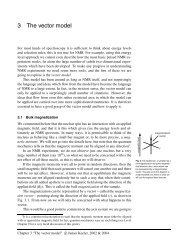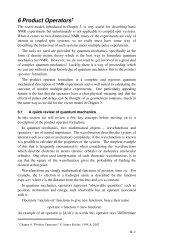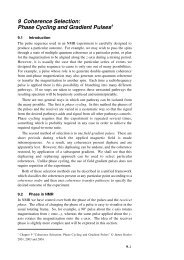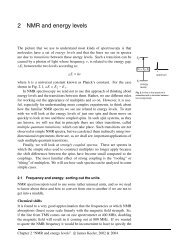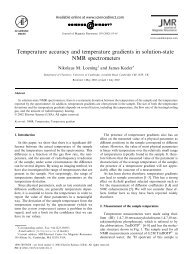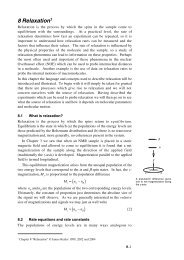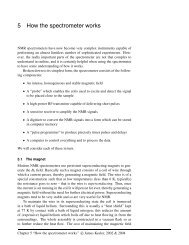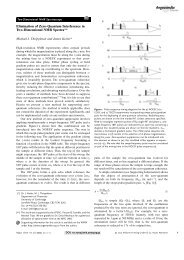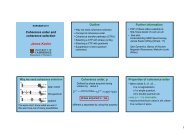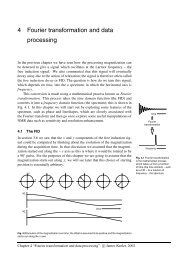Phase Cycling and Gradient Pulses - The James Keeler Group
Phase Cycling and Gradient Pulses - The James Keeler Group
Phase Cycling and Gradient Pulses - The James Keeler Group
Create successful ePaper yourself
Turn your PDF publications into a flip-book with our unique Google optimized e-Paper software.
p<br />
p<br />
p<br />
(a)<br />
RF<br />
2<br />
1<br />
0<br />
–1<br />
–2<br />
(b)<br />
RF<br />
g<br />
2<br />
1<br />
0<br />
–1<br />
–2<br />
(c)<br />
RF<br />
g<br />
2<br />
1<br />
0<br />
–1<br />
–2<br />
<strong>The</strong> ideal pathway, shown in (a), preserves coherence orders p = ± 2 during the<br />
inter-pulse delay. <strong>Gradient</strong>s can be used to select the pathway –2 to –1 or +2 to<br />
–1, shown in (b) <strong>and</strong> (c) respectively. However, no combination of gradients<br />
can be found which will select simultaneously both of these pathways. In<br />
contrast, it is easy to devise a phase cycle which selects both of these pathways<br />
(section 9.5.5.4). Thus, selection with gradients will in this case result in a loss<br />
of half of the available signal when compared to an experiment of equal length<br />
which uses selection by phase cycling. Such a loss in signal is, unfortunately, a<br />
very common feature when gradients are used for pathway selection.<br />
9.6.3.2 Selection versus suppression<br />
Coherence order zero, comprising z-magnetization, zz-terms <strong>and</strong> homonuclear<br />
zero-quantum coherence, does not accrue any phase during a gradient pulse.<br />
Thus, it can be separated from all other orders simply by applying a single<br />
gradient. In a sense, however, this is not a gradient selection process; rather it<br />
is a suppression of all other coherences. A gradient used in this way is often<br />
called a purge gradient. In contrast to experiments where selection is achieved,<br />
there is no inherent sensitivity loss when gradients are used for suppression.<br />
We will see examples below of cases where this suppression approach is very<br />
useful.<br />
9.6.3.3 <strong>Gradient</strong>s on other axes<br />
<strong>The</strong> simplest experimental arrangement generates a gradient in which the<br />
magnetic field varies in the z direction, however it is also possible to generate<br />
gradients in which the field varies along x or y. Clearly, the spatially dependent<br />
phase generated by a gradient applied in one direction cannot be refocused by a<br />
gradient applied in a different direction. In sequences where more than one pair<br />
of gradients are used, it may be convenient to apply further gradients in<br />
different directions to the first pair, so as to avoid the possibility of accidentally<br />
refocusing unwanted coherence transfer pathways. Likewise, a gradient which<br />
is used to destroy all coherences can be applied in a different direction to<br />
gradients used for pathway selection.<br />
9.6.4 Refocusing <strong>and</strong> inversion pulses<br />
Refocusing <strong>and</strong> inversion pulses play an important role in multiple-pulse NMR<br />
experiments <strong>and</strong> so the interaction between such pulses <strong>and</strong> field gradient<br />
pulses will be explored in some detail. As has been noted above in section<br />
9.5.3, a perfect refocusing pulse simply changes the sign of the order of any<br />
coherences present, p → –p. If the pulse is imperfect, there will be transfer to<br />
coherence orders other than –p.<br />
A perfect inversion pulse simply inverts z-magnetization or, more generally,<br />
all z-operators: I z<br />
→ –I z<br />
. If the pulse is imperfect, it will generate transverse<br />
magnetization or other coherences. Inversion pulses are used extensively in<br />
heteronuclear experiments to control the evolution of heteronuclear couplings.<br />
9–38



